 Japan, 1937-42. Fleet Aircraft Carrier
Japan, 1937-42. Fleet Aircraft CarrierWW2 IJN Aircraft Carriers:
Hōshō | Akagi | Kaga | Ryūjō | Sōryū | Hiryū | Shōkaku class | Zuihō class | Ryūhō | Hiyo class | Chitose class | Mizuho class* | Taihō | Shinano | Unryū class | Taiyo class | Kaiyo | Shinyo | Ibuki |The first purpose-built IJN fleet carrier
Another important landmark in the development of IJN air power, was the construction of the IJN Sōryū. Until then, following a parralel with the USN, IJN Hosho was the earlier equivalent to the USS langley, Converted IJN Akagi and Kaga, the answer to USS Lexington and Saratoga, and the IJN Ryūjō, the equivalent of the USS Ranger, a light carrier playing with the Washington’s treaty inconsistencies. She was the result of the London treaty, opening a new alley for Japanese medium carriers.
The IJN Sōryū was often paired with IJN Hiryū and indeed, they proceeded from the same program, as half sister-ships. But they diverged considerably, and the former paved the way to the excellent Shōkaku-class aircraft carrier completed in 1941, and in fact for a whole wartime generation of Japanese fleet aicraft carriers. IJN Sōryū’s career started immediately with the Sino-Japanese war and her actions with the Kidō Butai, followed its fate at Midway in June 1942.
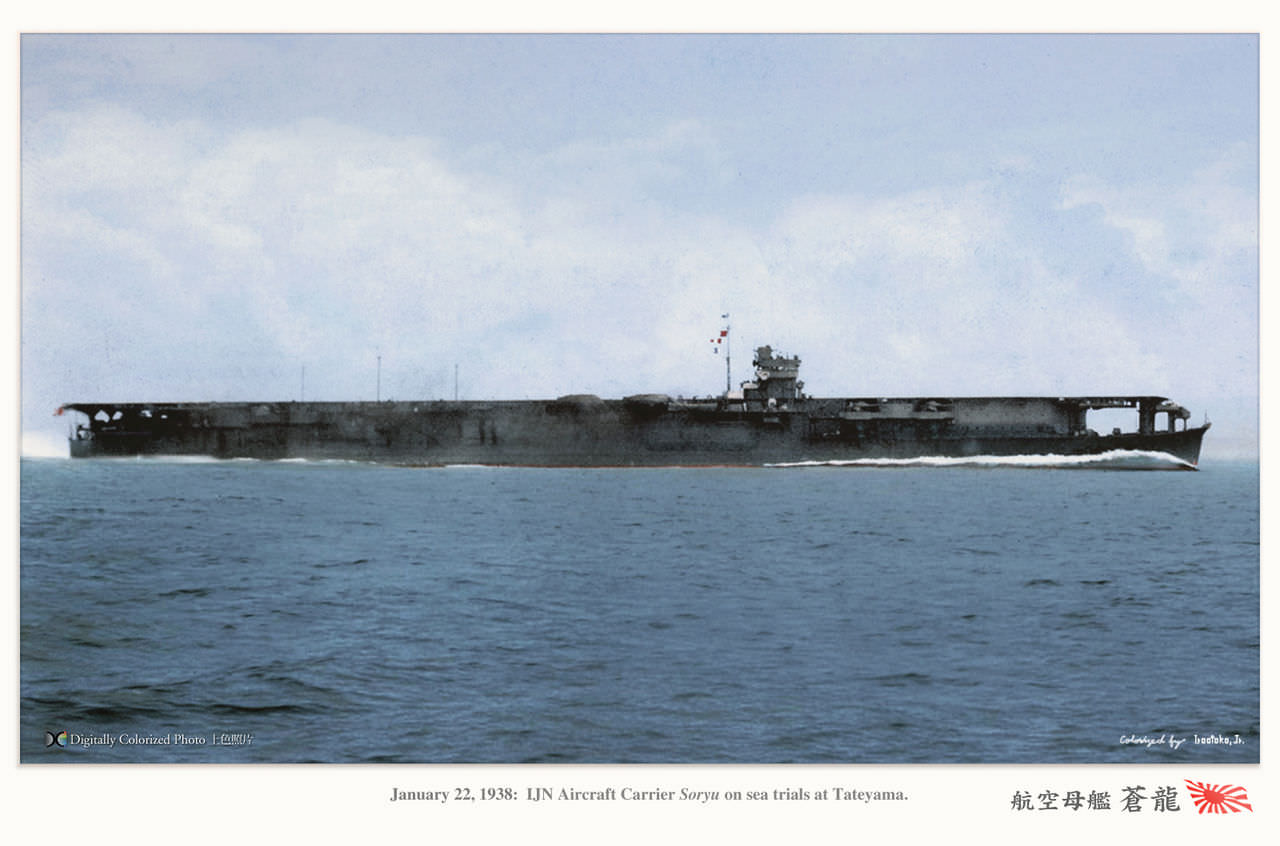
Design development
The London Naval Conference of 1930 at last allowed the Japanese to strengthen their carrier fleet as the parity with the USA and Great Britain and Japan shifted from 5:5:3 at Washington to 10:10:7 which was more favorable and opened an option for two more, larger aircraft carriers. Both ships were indeed built under 1st Supplementary Program of 1931.
IJN Sōryū was one of two new large carriers approved for construction, under the 1931–32 Supplementary Program with IJN Hiryū. This was a first as she was to be designed from the keel up as a medium fleet aircraft carrier. The main advantage of the time she was started, was to incorporate lessons learned from the light carrier Ryūjō. The latter as a reminder was built to exploit a loophole of the Washington treaty defining aircraft carriers by their tonnage; Below 10,000 tons.
The idea was to built swarms of these light carriers, outside the cap fixed in that category. Of course the treaty’s revision led to the closure of this in the 1930 London treaty, just as the first ship was built. So she remained alone, but experience with her led to an interesting starting point to develop a larger fleet carrier, while still relatively light, but maximizing aircraft capacity while using available treaty tonnage.
Context
During the Shanghai incident of 1932, 1st Koku Sentai, IJN KAGA and HOSHO were deployed to the Chinese coast, first opportunity for Japanese carriers to be tested in battle conditions, gaining invaluable operational experience. Around this time the impractical triple-deck arrangement on AKAGI and KAGA was abandoned and the two carriers were indeed scheduled to be rebuilt by 1935 and 1938. But the fleet still needed its first truly successful medium sized Japanese carrier. IJN SORYU and HIRYU were authorized under the Second Replenishment Program of FY 1934 which accentuated the expansion of naval aviation. In addition to two purpose-built carriers it included two fleet oilers TSURUGIZAKI and TAKASAKI, designed for rapid conversion to carriers (later SHOHO and ZUIHO). The general aim was to achieve parity with the United States naval air arm.
Of course, all aforementioned carriers were conceived in accordance with the tonnage restrictions of the Washington Treaty. It was hoped that by the time of HIRYU’s completion in 1937 the restrictions would be lifted, but in January 1936 the Japanese delegation withdrew from the new London Treaty talks. It was decided not to comply with the limitations of both Washington and London Naval Treaties any longer. After 1 January 1937, warship construction could proceed without further constraints.
1933 – start of the design process
First off, it was obvious in 1930 that the design of Ryūjō was top-heavy, especially after the admiralty decision to double the number of aircraft. At that stage, in 1933, it was clear on her first trials that she had serious stability issues and was downright dangerous. She was rebuilt in 1935. Still in 1933, the engineers at least started with a better basis, freed from the below 10,000 tonnes cap. The ship could have a larger, beamier hull, a slightly taller forward freeboard to cope with heavy weather and better hangar-prow combination, while accommodating a more reasonably shaped hangar, and not inheriting a tall tandem hangar.
The “Blue Dragon”, translation of her name, was still on specifications tailored for speed, and an emphasis on aircraft capacity over self defence. Targeting 16,000 tonnes, the admiralty still hoped to have three instead of two over the fleet’s carrier authorized tonnage at the time. In 1935, the Japanese indeed ripped their treaties altogether. The reasoning was the same as on the American USS Ranger, designed earlier (In 1930).
The beam was augmented by 50 cm (from 20.8 to 21.3 m or 69 feets 11 inches), and the overall length jumped to 227 m (746 feets 5 in) instead of 179 m, engineers preferring to stretch the design to add more capacity, which also favored a better length-width ratio and thus, again, overall speed. On Soryu, this ratio was of 10,65 versus 9 on Ryujo. For speed and agility it became evident that four shafts produced some advantages. Therefore, a four turbines arrangement was preferred, with eight boilers instead of six, resulting on a brute output of 152,000 shp versus 65,000 shp on Ryujo, almost double.
The end result, combined to the better ratio was to provide these ships a top speed well in excess of 32 knots, whereas Ryujo was limited to 29 knots, just sufficient to act with battleships. For Soryu, it was expected to use these carriers in night operations with the latest IJN heavy cruisers, and therefore a top speed of 34-35 knots was targeted. The new design was also required to carry more planes, in this case 63 plus nine in reserve so an overall 72, versus 48 on Ryujo (and that was with spares and in 1933, the size of aircraft downgraded this massively until 1942).
1934 – The design is refined
With all this in mind, the engineers responsible for the design submitte their final proposal in early 1934, wich was approved and blueprints prepared by the chosen naval yard of Kure Naval Arsenal. Construction at last started on 20 November 1934 when her keel was laid down. This was more than one year and a half after USS Ranger had been launched already. In Comparison, the latter was slightly shorter, but beamier, slower, but carried more planes, a grand total of 86 as built, which was remarkable for such light tonnage. In between, design proceeded on the next generation of aircraft carriers in the USN, the Yorktown class, and both navies were capped by the same global 135,000-ton Treaty limit.
The new design, worked out from 1933, targeted 90 planes, but on a better balanced 19,000 tonnes basis. Meanwhile, the Japanese proceeded with IJN Hiryu (“Flying dragon”), a virtual copy of the first, with two years of gap, but with enough difference not to be considered as a true sister-ship. No naval historian today attached them in the same class anyway.
With their post-1935 “treaty out” approach, Japanese engineers were free at last to design in 1936 the “ideal fleet carrier”, the Shokaku class, dubbed by many historians as “arguably the best aircraft carriers in the world” when built. They started with almost double the tonnage (32,000 tonnes), nine meters more in beam but still a slightly inferior aviation complement to the taller and roomier Yorktown, with “only” 72 operational planes and 12 spares so a total on paper of 84. The output was superior, so that despite their larger tonnage they still managed to reah more than 35 knots on trials, and the best defensive armament so far.
It is important to note that the Japanese outright lied in official publications on their CVs, officially for 10,050 tons standard. Their true tonnage was not revealed until the end of WWII. Nevertheless, if the “Soryu class” was overly successful, at least from the Japanese perspective, they were lacking good aircraft facilities, compared to contemporary HMS ARK ROYAL and USS YORKTOWN. Their aircraft-handling facilities were not modern, but improved on the next Shokaku class.
In fact it was hoped that by the time of HIRYU’s completion in 1937 the restrictions would be lifted, but in January 1936 the Japanese delegation withdrew from the new London Treaty talks. It was decided not to comply with the limitations of both Washington and London Naval Treaties any longer. After 1 January 1937, warship construction could proceed without further constraints.
Detailed Design of IJN Sōryū

Deck and hull plan in 1941
The final design of IJN Sōryū called for a long hull as precised earlier, with a remarkable set of differences compared to Ryujo. Her prow was taller from the start (three stages high) but the height of her main two hangars was quite low, allowing the ship to avoid topweight issues. The internal distribution was in reality more complex with a separate hangar and workshop containing the spare planes and a repair space, plus ammo parks (gasoline tanks, aerial torpedoes, bombs, machine-gun cartridge bands, etc.), which were lower, so as to keep a balanced metacentric height. This was still not however a massive departure from Ryujo as rebuilt.
Hull and protection
If Ryujo was an unsatisfactory compromise, in short, a failed aircraft carrier, Soryu was the prototype for all following IJN aicraft carrier designs: Fast, lightly built, designed to deliver blows but not taking them. The hull measured 227.5 m (746 ft 5 in) overall but 210 (688 ft 9 in) at between parallels, 222 m (728 feets) at the waterline, for a beam of 21.3 m (69 ft 11 in), also at the largest hull section, not on the flight deck, and 7.62 m (24 ft 11 in) of normal draught.
Armour protection was not the overriding priority there. It was to be adjusted where and when the most needed and not more. It never passed 2.2 inches in thickness, and this was the deck over the ammunition magazines and aviation gasoline storage tanks (55.88 mm) with Ducol steel, down to 1 inch (25,4 mm) over the machinery, whereas the belt was only 1.6 to 1.8 inches thick (41-45,72 mm) with an internal anti-splinter bulkhead.

Soryu after launch, fitting out at the Kure Naval Arsenal in 1936
ASW compartimentation was of course pushed just enough to include a full separation of the machinery, between the four turbines, outer and inner shafts, and the boilers surrounded by many compartiments designed to absorb any torpedo blast, and at the bottom, a double hull running for about 70% of her lenght. But she had no bulges.
This ASW protection was more optimized against lighter aerial torpedoes than regular marine torpedoes, and it was believed their high top speed was a good argument against torpedo hits. Protection against aerial bombs however was limited to the “sandwich effect” of the two decks below the main and secondary hangar, plus the waterline deck. It was not sufficient at Midway, but because of the way ammunitions and fuel was stored and used inside the first hangar itself, where the damage was done. At that stage, no thoughts were given to armored decks. This was a close prewar British idea, and a very good one as shown by events in the Mediterranean.
Powerplant
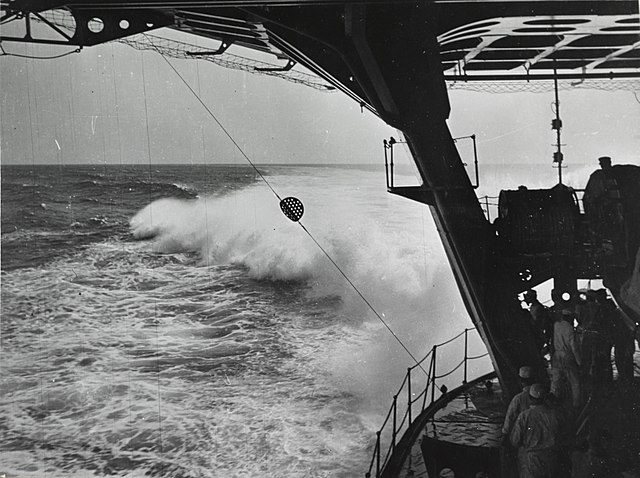
Fantail view, IJN Soryu on trials at 35 knots
The machinery was without contest the main selling point of the design. It was enormous for an aircraft carrier at the time for that tonnage, beating all standards. IJN Sōryū was propelled by four shafts, two outer and two inner, drove by four geared steam turbine sets, with a total of 152,000 shaft horsepower (113,000 kW). Steam came from eight Kampon water-tube boilers. These turbines and boilers were just borrwoed from the contemporary Mogami-class cruisers.
This sort of raw power combined with her slim, cruiser-type hull gave her a speed of 34.5 knots (63.9 km/h; 39.7 mph): This made her in 1937 the fastest aircraft carrier in the world at the time, when commissioned. She carried 3,710 metric tons (3,650 long tons) of fuel oil for an overall range of 7,750 nautical miles (14,350 km; 8,920 mi) at the cruis speed of 18 knots (33 km/h; 21 mph). The boiler uptakes were trunked together on her starboard side amidships, still below flight deck level, so to exhaust just below that level with two funnels curved downwards to avoid releasing smoke. The whole package was virtually repeated on IJN Hiryu.
Armament
IJN Sōryū was to be lightly armed, focusing on anti-aircraft armament as it was believed in 1934 onboard fighters had the primary duty to defend their carrier. Hwever ro procure a long range AA defence against bombers, and capabilities in a still possible naval fight, Soryu was fitted with twelve 127 mm/50 (5 inches) in three twin-gun mounts on either side. Two were closer together aft port and two forward on starboard. The Type 89 dual-purpose guns rested on projecting sponsons. They had a max range of about 14,700 meters (16,100 yd), but a practical ceiling of 9,440 meters (30,970 ft) when elevated at 90°. Maximum rate of fire was 14 rpm, 8 rpm sustained. They were assisted and directed by two Type 94 fire-control directors also mounted on sponsons, one of each side, but the starboard director mounted on the island was able to cover all sides and therefore control all this artillery if needed.
The second layer of active AA protection consisted of fourteen twin-gun mounts (28) license-built Hotchkiss 25 mm (1 inch) Type 96 AA guns. Three were located on a platform below the forward end of the flight deck, the rest were located in sponsons along the flight deck, three on the opposite side of the island, followed by three others mid-ship, then five heavenly spaced in between the aft 127 mm mount on the other side. However as in the previous designs, all three main sponsons were mounted below the flight deck level and could only cover half of the ship.
The ubiquitous 25 mm was a known standard issue light AA weapon suffering from severe design shortcomings, like being unable to be trained or elevated fast enough, with mediocre sights for high-speed targets, excessive vibration, muzzle blast and noise. Effective range was 1,500–3,000 meters (1,600–3,300 yd), with 5,500 meters (18,000 ft) of ceiling at +85° and 110-120 rpm with 15-round magazines. To serve these, five Type 95 directors were installed on each side of the flight deck and one in the bow. In 1938, gun shields were added to protect both the 127 and 25 mm mounts.
Aircraft facilities

Section of the island cutaway drawing, Extract from Kagero’s book on IJN carriers.
Sōryū’s flight deck was as customary shorter than her hull, at 216.9 m (711 ft 7 in) overall, but for 26 m (85 ft 4 in) in width. There was the customary overhang at both ends, and it supported by pairs of pillars. fore and aft. Her island was built on starboard on a extension protruding beyond hull, not encroaching on the flight deck. It was a small and narrow model reminiscent of what was done on Akagi, with a main enclose bridge and open brige above, and two small utility rooms below. On top of it was located a serie of binoculars for the watch and aft the large main telemeter for the 5-in guns.
The flight deck was criss-crossed by nine transverse arrestor wires starting at the level of the exhausts, and going back about 60m short of the end of the flight deck. These could could stop a 6,000 kg (13,000 lb) aircraft. In addition, there were two folded safety nets in case of an overshoot, one located abaft the forward exhaust and another forward.
The flight deck due to the particular way the ship was tretched out, was low over the water, only 12.8 meters (42 ft), the lowest since Hosho. The designers reduced indeed the height of the hangar, with a main upper hangar 171.3 long (562 feets) and 18.3 metres wide (60 ft) but just 4.6 meters (15 ft) in height, while the lower hangar was shorter at 142.3 m (467 feets) by 18.3 m (60 ft) and just 4.3 m hight (14 ft 1 in).Total area for parking was 5,736 Sq. metres (61,742 sq ft). These hangars were so low in fact, contrary to US paractice allowing spare planes to be just suspended under the ceiling, that the tails and folded wings sometimes reached the ceiling. The Nakajima B5N “Kate” torpedo bomber when introduced was a particular difficult fit inside, condemned to the 1st hangar, or the flight deck as it could neither have its wings spread or folded inside.
There was also a recovery crane starboard aft, close to the aft offset lift, to recover water crashed planes and floatplanes. It was carried folded into a recess of the flight deck. The latter was colored, with a central section, starting roughly 10 meters forward of the island, and ending after the rear lift, in clear pine wood, and metal deck forward and aft. There was a white bearing mark forward and central white line running all the way to the aft section, and a white/red painted aft section for landing, with wings extensions for aiming.
The 60 strong air group was distributed from the two hangars to the flight deck via three elevators: The forward one was the largest at 16 by 11.5 meters (52 ft 6 in × 37 ft 9 in), rectangular in shape to fit in a “Kate” wings unfolded. It was located abreast the island, centerline but the two others were squarish and offset to starboard, a better fit for fighters. The first was 11.5 by 12 meters (37 ft 9 in × 39 ft 4 in), the rear one, smallest, was 11.8 by 10 meters (38 ft 9 in × 32 ft 10 in). All three had a lifting capacity uo to 5,000 kilograms (11,000 lb). To serve this air group, IJN Soryu’s total gasoline capacity was 570,000 liters (150,000 U.S. gal).
Onboard aviation
Her air group was initially planned to include eighteen Mitsubishi A5M, twenty-seven Aichi D1A2 dive bombers, and twelve Yokosuka B4Y Type 96 torpedo bombers but the Nakajima A4N1 was issued instead.
(Dedicated Illustrations in preparation)
Completed in 1937, IJN Soryu was given only biplanes, transitioning to monoplanes from 1938 and until 1941. She operated in short succession the A2N, A4N, and finally A5M, A6M fighters in WW2, but also the D1A, D3A diving bombers and the B4Y and B5N torpedo bombers. At Pearl Harbor, she carried 21 Mitsubishi A6M Zero, 18 Aichi D3A and 18 Nakajima B5N for a total of 57, plus 11 in ready reserve to replace losses, and 9 more to be assembled to replace the latter (or be cannibalized). This basically was the same air group at Midway, barely six months later.
-The Nakajima A2N (1929) was already an old biplane introduced in 1936. Pilots trained with it, the very first squadrons tested comprised some Navy Type 90-III (A2N3) Carrier-based fighter, which mostly flew from the Hōshō, Kaga and Ryūjō. They were quickly replaced by the A4N or some possibly flew for early tests in 1937, according to navypedia.org.
-The Nakajima A4N1 (1934) was the replacement for the A2N, introduced in 1936 and quickly became the main fighter of Soryu from 1937 to 1938, used extensively over China. It was not given any codename by ONI, as considered obsolete in 1941. It was a stopgap before she received her planned A5M, in short supply.
-The Mitsubishi A5M “Claude” (1935) first IJN monoplane, but with open cockpit and fixed undercarriage was introduced in the IJN in 1936, so as IJN Soryu was still fitting out. It however replaced the A4N in 1938 when available. By that stage, it was probably the A5M3, replaced by the A5M4 variant in 1939. It was still used in 1941.
-The Mitsubishi A6M “Zeke” (1940) arrived just in time, to be precise, the A6M2, for Pearl Harbor. They became the mainstay of the carrier until her loss in June 1942, as there is no clue the A6M3 replaced it. The latter was mostly available from November-December 1942.
-The Aichi D1A “Susie” (1934) was her first dive bomber, a biplane, but brand new when she was completed. It was retired in 1942, but on second-hand units, whereas on Soryu it was retired well before the attack on Pearl Harbor, meaning Soryu lacked for a short time a dedicated dive bomber, before the “Val” arrived, with pilots fresh from training.
-The Aichi D3A1 “Val” (1938) was introduced from 1940 and replaced the D1A on all IJN carriers gradually in 1941. Given the schedule for the December attack, pilots trained intensively all the winter, on land bases and on IJN Soryu. This was still the frontline dive bomber on board at Midway.
-The Yokosuka B4Y “Jean” (1935) was the only torpedo biplane onboard IJN Soryu, introduced when she was fitted out. It equipped the carrier when commissioned and soldiered on for most of the Sino-Japanese war until declared obsolete.
–The Nakajima B5N “Kate” (1937) was the arguably most modern torpedo plane in the world when introduced in 1938. It had better caracteristics than the Devastator. It was probably available in sufficient numbers to replace the B4Y in 1940 already, leaving plenty of time for Soryu’s pilots to train for Pearl Harbor.

Nakajima A4N1 fighter, which only served two years onboard Soryu.

Mitsubishi A5M4 “claude”, Soryu 1939. In 1941, she was replaced by the A6M.
Comparison with IJN Hiryu
The most striking aspect with IJN Hiryu was her taller bow, four stage high (four rows of portholes) compared to just two on the initial Ryujo design, and three on Soryu. No risk ever she “plowed” in heavy weather of her deck being washed up to the hangar by tall waves as it happened previusly. Interestingly also, the ratio between the hangar’s height coppared to Ryujo’s was reverse. It was 50% on Soryu. The hangar was much lower, although seating higher up over the main deck.
For armor, IHN Hiryu was much better protected, with 90 millimeters (3.5 in) over the machinery spaces and aviation gasoline storage tanks and even 150 millimeters (5.9 in) over the magazines, quite a stretch.

Author’s illustration of IJN Sōryū in May 1942
⚙ Specs 1937 |
|
| Dimensions | 227,5 m (746 ft) x Beam 21.3 m (69 ft) x Draught 7.6 m (24 ft) |
| Displacement | 16,200 long tons standard, 17,100 long tons FL |
| Propulsion | 4 shaft Kampon geared steam turbines, 8 Kampon boilers 152,000 shp |
| Speed | 34 knots (63 km/h; 39 mph) |
| Range | 7,750 nmi (14,350 km; 8,920 mi) at 18 knots (33 kph, 21 mph) |
| Armor | Belt 41 mm (1.6 in), see notes |
| Armament | 6×2 12.7 cm (5 in) DP, 14×2 25 mm (1 in) AA, 70 planes |
| Crew | 1100 |
Sources/ Read more
https://en.wikipedia.org/wiki/Japanese_aircraft_carrier_S%C5%8Dry%C5%AB
Conway’s all the worlds fighting ships 1922-1947
https://ship.fandom.com/wiki/IJN_S%C5%8Dry%C5%AB
http://www.combinedfleet.com/ships/hosho
https://www.militaryfactory.com/ships/detail.asp?ship_id=ijn-hosho-aircraft-carrier
The model’s corner

Model kit 1/700, Tamiya’s boxart
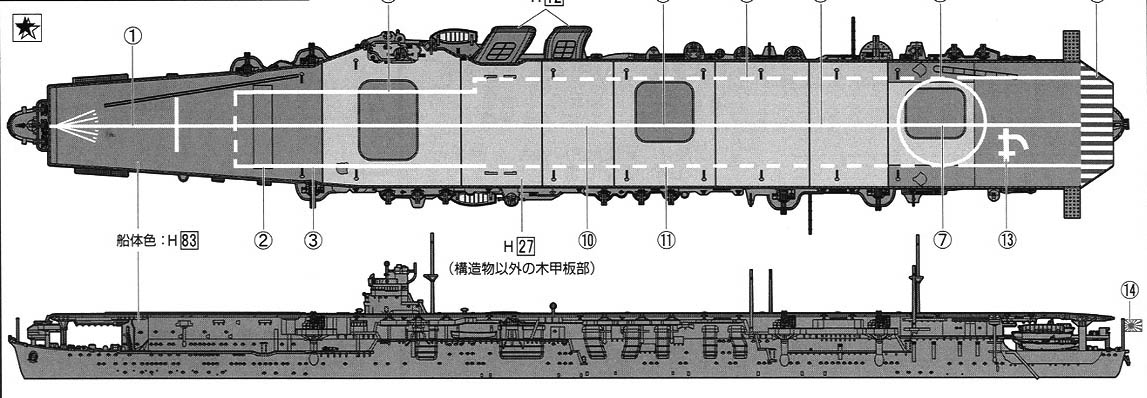
Tamiya 1/700 waterline color set boxart
IJN Soryu’s career
Interwar service
Interwar service
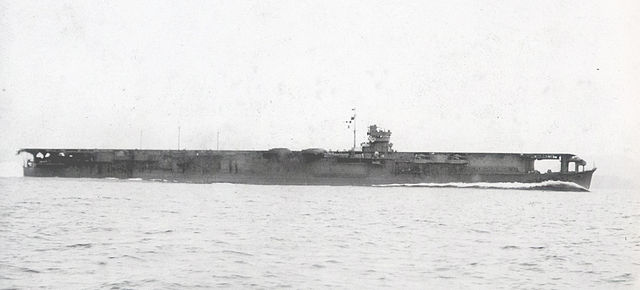
IJN Soryu in 1938
On 16 August 1937, Sōryū was fitting out, with Captain Akitomo Beppu assigned as Equipping Officer. On 1st December Beppu was relieved by Captain Kimpei Teraoka and on the 29th she was at last Commissioned in IJN, and assigned to Yokosuka Naval District, Second Fleet (second carrier division or CarDiv 2). On 9 April 1938 she departed the Terashima Channel and sailed to the South China Se, arriving at Takao, Taiwan on the 15th, starting a training session before being back to Japan. On 25 April 1938 she delivered indeed nine A4Ns, eighteen D1A2s, and nine B4Ys to Nanking air base, for a daily support of IJA troops advancing along the Yangtze River. This air group took part in many successful offensives, dealing blows to the Chinese Air Force and Soviet Volunteer Group until it was transferred to Wuhu in early June and then Anqing.
On 8 May 1938, she was considered ready and departed Sasebo for her first tour of duty along the Chinese coast. On 4 June 1938 she departed for maintenance and crew’s rest at Yokosuka. eanwhile, leaving a few fighters and their pilots behind as the nucleus of a new fighter unit, this air group returned to Sōryū on 10 July. On 9 October 1938, she was in Mako, and sailed again to operate in South China Sea, arriving at Takao on 14 November. The following day she hosted her new captain, Keizo Uwano. She was back home later, spending most of the next year and a half training.
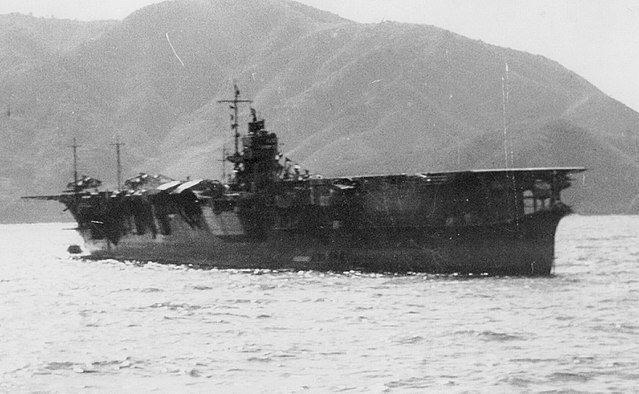
Japanese aircraft carrier Soryu 02 Kuriles Islands 1939
On 21 March 1939 she departed Sasebo for another tour of duty in the East China Sea, until 2 April 1939 when she headed back to Sasebo. On 15 October 1939 Captain Uwano was relieved by Captain Sadayoshi Yamada and on the 31th she departed Yokosuka for her third tour of duty, until retired for resplenishment at Okinawa. On 26 March 1940 she departed Nakagusuku Bay (Okinawa) for a fifth round of operations in the South China Sea with her near sister IJN HIRYU. From 2 April 1940 she was stationed in Kirun, Taiwan. On 1st May 1940 she was back in Yokosuka for maintenance, short overhaul and prolongated crew’s rest. She departed on 29 May 1940 for a drydock period at Yokosuka Navy Yard until 6 June 1940, proceeding two days later to Tateyama, embarking a new air group, and on 22 June 1940 sailed to Kisarazu for training before being back to Yokosuka on the 29th.
On on 5 July 1940, Soryu sailed to Tateyama for training and was back on the 22th to Yokosuka, departing on the 24th for Hakodate, Hokkaido, then saled to Ise Bay in August, proceeded to Saeki Bay in Kyushu, Sukumo Bay in Shikoku, Beppu in Kyushu and back to Yokosuka on 2 September 1940, drydocked until 11 October 1940. Captain Wataru Kamase too command on the 15th, and she return in drydock on 2 December 1940 for a short overhaul, proceediong on the 17th to Tateyama, then Ariake Bay, Kyushu, Kure for modifications (Iwakuni). She departed to participate in large naval maneuvers off Taiwan. During these on 3 February 1941 she collided with the destroyer YUZUKI.
On 6 February 1941 she entered Sasebo for repairs, until the 18th and she was back in Takao to join HIRYU. CarDiv 2 departed Takao on the 22th for Nakagusuku Bay before going back on 3 March 1941 to Takao, then Ariake Bay and back to Yokosuka on the 26th, assigned to the newly created First Air Fleet (Kido Butai), still CarDiv 2, paired with IJN HIRYU. On 20 April 1941 they sailed to Tateyama and on 20 May 1941 she trained with HIRYU in Ariake before going back to Yokosuka, departing on 10 July 1941 to support the invasion of southern French Indochina. On 16 July 1941 they were off Samah, Hainan, reaching port Cap St. Jacques and back to Samah in August, covering the invasion and occupation, and she also took part in the blockade of southern China. Her air group was detached in mid-July, transferred to Hainan Island to support the occupation of southern Indochina. She was back home on 7 August 1941 in Sasebo for maintenance and crew’s rest. She also became flagship of the 2nd Division. She trained later this month off Kyushu until September 1941, back to Yokosuka. On the 12th Captain Kiichi Hasegawa (formely on IJN AKAGI) took joint command while the aicraft carrier was drydocked at Yokosuka Navy Yard in October, Captain Ryusaku Yanagimoto taking sold command before the ship leaves drydock after a short refit completed on 24 October. She made some training as flagship at Kagoshima, and arrived at Kushikino (Kyushu) for more training, Ariake Bay in November, before heading for Kure, Saeki as CarDiv 2 departed on the 18th for an action in the Kuriles, anchoring in Hitokappu Bay, Etorofu, the gathering point of the 1st air fleet under Vice Admiral Chuichi Nagumo, for the attack of Pearl Harbor. On 26 November 1941, she Departed for Hawaii from there to avoid known shipping lanes.
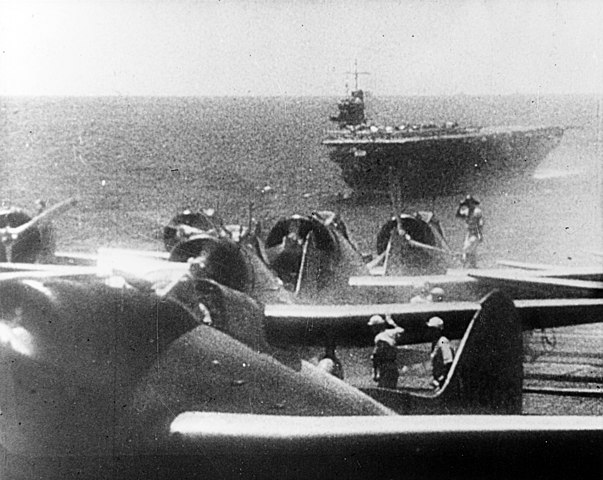
Japanese planes preparing Pearl Harbor, Soryu in the backround
Wartime Operations from Pearl Harbor to Midway
On 7 December 1941 the 1st air fleet and CarDiv 2 arrived in position north 230 nautical miles (430 km; 260 mi) north of Oahu, pilots preparing at noon for the the Attack on Pearl Harbor. IJN SORYU launched like the rest of the fleet two succesive strikes. The First comprised 18 Kate torpedo bombers (Led by Lt. Tsuyoshi Nagai, Lt. Heijiro Abe) escorted by 8 Zero fighters (Lt. Masaharu Suganami). Eight of her B5Ns were supposed to attack the aircraft carriers normally berthed on the northwest side of Ford Island, only to found they were absent and focus on other ships. Six were detached to attack and sink the target ship Utah, and also the cruiser USS Raleigh, badly damaged. Two other pilots attacked ships berthed alongside “1010 Pier” and found in drydock the light cruiser Helena and minelayer Oglala. A torpedo missed Oglala but struck Helena. The other pilot instead attacked USS California.
Meawnhile the dive bombers also attacked Battleship row as planned. The ten B5Ns dropped their 800-kilogram (1,800 lb) armor-piercing bombs on the southeast side of Ford Island, reported scoring one or two hits. Her eight A6M Zeros strafed the Marine Corps Air Station Ewa and claimed to have burned twenty-seven aircraft, shooting down five more in the sky. Meanwhile Soryu’s flight deck was crammed with the prepared planes of the second wave, 18 Val dive-bombers led by Lt.Cdr. Takashige Egusa escorted by 9 fighters (Lt. Fusata Iida). During the operations, her air group lost 4 Vals and 3 Zeros, also Lt. Iida. They attacked on the Naval Air Station Kaneohe Bay. One Zero was lost to AA fire. Zero pilots claimed on their way down two American aircraft, loosing two of their own. The D3As of the second wave continue pounding the battle ship row, but it was not possible to determine what ship they hit, and two of them were shot down due to AA fire.
Attack on Wake
On 21 December 1941 CarDiv 2 was detached from the 1st air fleet to support the Second Invasion of Wake. She launched the first strike consisting of 18 dive-bombers and 18 fighters. On 22 December 1941 she launched a second strike against Wake with 18 Kates and 18 Zeros, loosing two “Kates”. Indeed they were intercepted by the two surviving Grumman F4F Wildcat fighters of VMF-211. They were shot down themselves by escorting Zeros. On the 23, Soryu departed for home, arriving on the 29th at Kure for overhaul and replenishment.
Battle of the Philippines
On 11 January 1942 she was back at sea, Proceeding to Hashirajima before heading for Palau and on 23-24 January 1942 CarDiv 2 launched two strikes against Ambon, in support of the Kendari landings before making it to Davao, Mindanao. So they swapped from the invasion of the Palau Islands and Battle of Ambon to the invasion of the Philippines, but did not took part in it. During their initial strike, CarDiv 2 was able to put in the air 52 planes total. The carriers also detached eighteen Zeros and nine D3As to operate from land bases, in support of the Battle of Borneo. On 30 January, they shot down two aircraft on the ground and a Qantas Short Empire flying boat en route to Surabaya.
Raid on Darwin
On 28 January 1942 IJN Soryu was in Palau for resplenishment and meeting Kaga and Akagi, before departing on 15 February 1942 to Australia. She participated in a major raid over Port Darwin, Australia, but damage was far less impressive than in Pearl Harbor. Anyway, Soryu contributed 18 B5Ns and 18 D3As, escorted by 9 Zeros, the rest staying in a flying Combat Air Patrol (CAP). Eight ships were sunk or badly damaged, mostly civilian, three beaching to not sink. Zeros claimed a single Consolidated PBY Catalina and one D3A was lost (probably to AA). They also spotted a ship on a return trip, but coilod not attack, short of ammo. They had to be rearmed and refueled onboard, and several hours later, nine D3As located and bombed the supposed same ship, the American supply cargo of 3,200 GRT Don Isidro. She was hit five times but failed to sink, amazingly.
Battle of Java
On 21 February she was in Staring Bay, Celebes, departing to support the invasion of Java Island, Battle of Java. SORYU and AKAGI sunk the oiler USS PECOS during operations, and on 5 March 1942 the two CarDiv 2 carriers launches a strike against Tjilatjap in Java. On 7 March 1942 the division launched a strike against Christmas Island and on 11 March 1942 was back to Staring Bay for resplenishing, departing on
26 March 1942 to join the rest of the fleet and participate in the next big operation.
Raid to the Indian Ocean
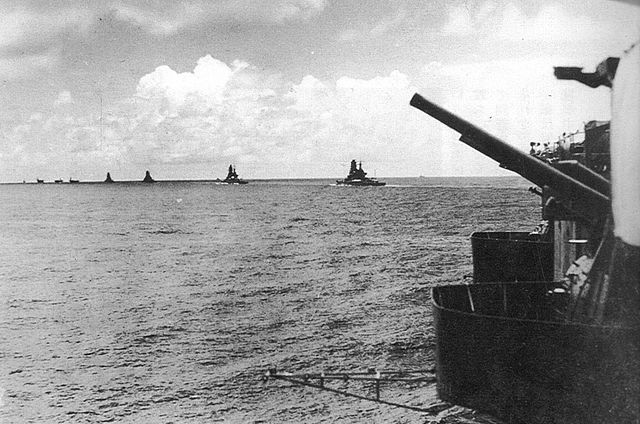
IJN Soryu in the Indian Ocean 1942
This large operation was intended to secure newly conquered Burma, Malaya, and the Dutch East Indies, making impossible any Allied counter-attack from there for at least several months. The Kido Butai (two divisions) was tasked of destroying base facilities and all present forces in the area. Departing on 26 March 1942, the five carriers were spotted en route by a Catalina, about 350 nautical miles (650 km; 400 mi) southeast of Ceylon. On 5 April 1942 SORYU launched a strike from 120 nautical miles (220 km; 140 mi) against Colombo (Ceylon). Her pilots claimed to have shot down a Fairey Fulmar (806 Naval Air Squadron) and seven other fighters, conceding one. D3As and B5Ns inflicted in the end little damage to the port facilities as after the warning has been given, learly all traffic in the port was at sea.
Latter, spotter planes found HMS CORNWALL and DORSETSHIRE another strike force from Sōryū of eighteen D3As took off, led by Lt.Cdr. Egusa. They found the two cruisers and were the first to engage them, claiming 14 hits on both heavy cruisers. They were finished off by other waves. On 9 April 1942, Soryu launched the second strike planned against Trincomalee. Soryu’s B5Ns were the first over the port while fighters met no opposition and instead started to strafe the installatons.
Meanwhile, a floatplane from IJN Haruna spotted the HMS Hermes, used as plane transport, escorted by the Australian destroyer HMAS Vampire. As soon as they were ready, every available D3A was launched and again, Sōryū’s squadron comprised eighteen dive bombers but they arrived too late as the ship was already catch up and sank by other waves. Instead this squadron spotted three other ships further north, the oil tanker British Sergeant and Norwegian cargo ship Norviken. Both were sunk. However since they were close to the coast, alert has been given and they were attcked by eight Fulmars from 803 and 806 Naval Air Squadrons. They claimed three D3As, conceding two Fulmars while actually four D3As were lost, five damaged, proving the “jack of all trade” British naval plane was equal to the task.
Meanwhile, IJN Akagi narrowly escaped a raid from eight British Bristol Blenheim bombers from Ceylon. The latter dropped their payload at 11,000 feet (3,400 m), proving these tactics fruitless. Sōryū contributed to the CAP with six Zeros in the fourteen which collectively accounted for five Blenheim, conceding on Zero from Hiryū. The First Air Fleet reversed headed southeast (Malacca Strait) recovering their air groups in between, and went home on 22 April 1942.
Soryu at Midway
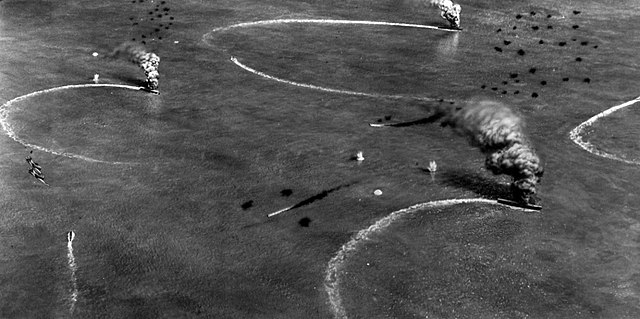
Kaga Akagi and Soryu under attack Midway diorama
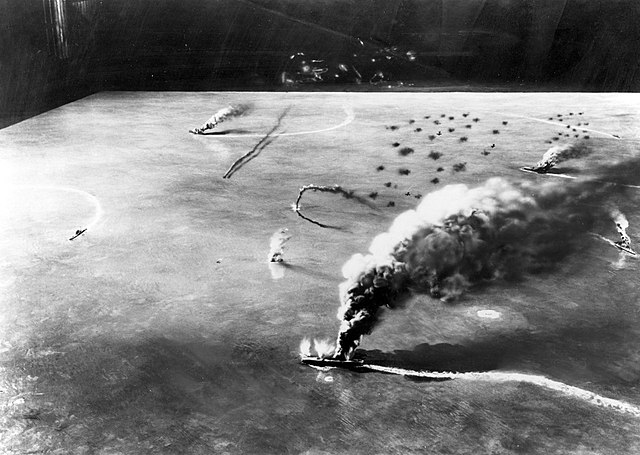
Battle of Midway diorama
Before Midway, and before joining home island, the Kido Butai and CarDiv 2 led by Soryu were transiting the Bashi Straits between Taiwan and Luzon on 19 April when a counter-order came to be sent in pursuit of the American carriers USS Hornet and Enterprise on their way back from the Doolittle Raid. They found none, the latter already back to Hawaii. They dropped anchor at Hashirajima on 22 April and needed badl an overhaul and rest after 4,5 months of uninterrupted activity. IJN Sōryū however was still needed elsewhere and hurriedly refitted and replenished, in preparation for the next major operation directed against Midway. Sōryū’s air group was based ashore at Kasanohara for extensive training with the other First Air Fleet squadrons.
On 27 May 1942, she departs Hashirajima with the rest of the unit, the same Kaga/Akago of the 1stDivision and her near-sister ship Hiryu of the second in order to participate in “Operation Mi”.
Yamamoto’s bold “trap” aimed at finishing off the beleaguered American carrier force that remains from the recent air-sea battle at Coral Sea. He decided to invade and occupy Midway Island, an in-between too close to Hawaii for comfort. For this, he needed to lure out the American carriers, waiting with the main fleet in ambush. On 25 May 1942, Sōryū departd with a completed and well trained air group, with eighteen Zeros, sixteen D3As, eighteen B5Ns, plus two prototypes of the brand new Yokosuka D4Y dive bomber, plus three additional A6M Zeros (6th Kōkūtai) to deal with Midway and be later based there.
The fleet was placed 250 nautical miles (460 km; 290 mi) northwest of Midway, arriving at dawn on 4 June 1942. IJN Sōryū launched her planes which joined a 108 strong combined air raid, targeting the airfield on Midway’s eastern island. She launched eighteen torpedo bombers, escorted by nine Zeros. She lost a single B5N (by fighters) two ditching on the return at extreme range and five damaged beyond repair. Meanwhile the US informed by their Intel were ready.
Sōryū alaunched 3 Zeros (out of 11) assigned to the initial CAP, helped to stem a frst wave from Midway Island at 07:10, notably six Grumman TBF Avengers (VT-8), four USAAC Martin B-26 Marauders also with torpedoes. Hiryū was attacked by the Avengers, which was their cmbat debut, a bit like the the Marauders attacking meanwhile Akagi. Five Avengers, two B-26s were shot down, and they all missed. Sōryū then launched three more Zeros, expecting more attacks.
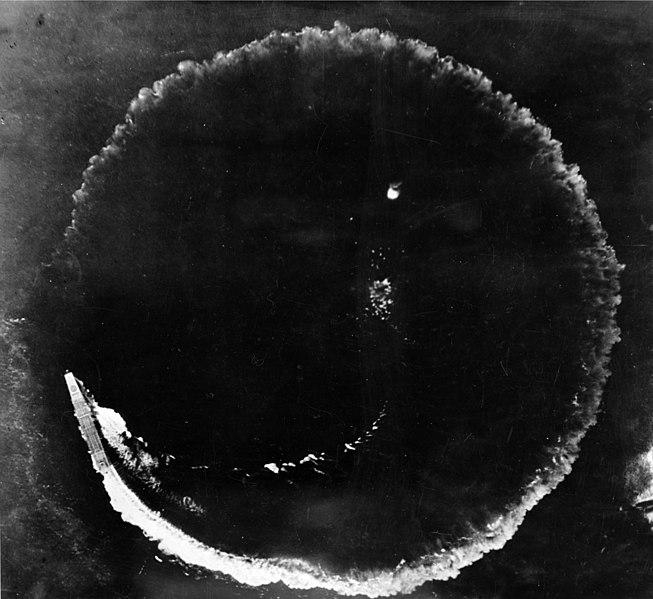
Aerial view IJN Soryu evading an air attack, 4 June 1942
At 07:15 Nagumo ordered Kaga & Akagi planes to be rearmed with bombs, but it became a long process, and the order was reversed at 07:40 when news camed USN warships had been spotted. Meanwhile, Sōryū’s CAP Zeros landed back to resupply. At 07:55, sixteen Douglas SBD Dauntless of VMSB-241 were met first by Sōryū’s three CAP fighters, claiming six. 12 USAAC Boeing B-17 Flying Fortresses soon appeared above and carpedt-bombed the IJN formation, also without result from 20,000 feet (6,100 m). Sōryū saw a few “far misses” as it was not accurate. She kater constributed shooting down eleven Vought SB2U Vindicator dive bombers (VMSB-241) and at 08:20 the USN American carrier force was spotted to the northeast prompting Sōryū at 08:30 to launch a single D4Y to confirm their exact location. Soon after, she started recovering her planes back from Midway.
This was over at 09:10, and these were quickly struck below to be prepared for strike against the USN carrier force, interrupted at 09:18 as a first incoming waves from these arrived.
Fifteen Douglas TBD Devastator (VT-8, Lt.C. John C. Waldron, from Hornet) came first, just as her CAP Zeros were landing to be refuelled at 09:30. They concentrated on Soryū, but they were dealt for by other Zeros in the CAP while Soryu was manoeuvering at full speed. Son after, fourteen Devastators from VT-6 (USS Enterprise) tried to sandwich Kaga, but were also shot down by the CAP now augmented by Sōryū’s Zeros. Sōryū also soon launched her three other CAP Zeros at 10:00, three more at 10:15, but conceded one to an escorting Wildcat with VT-3.
However around 10:20, miracusliously all dive bombers arrive don site about the same time and fell onto the four carriers. At 10:25, Sōryū was targeted along by no less than thirteen Dauntlesses, Yorktown’s VB-3. She received three direct hits, all being from 1,000 lb (454 kg) bombs, penetrating the lower hangar deck amidships or exploding in her upper hangar deck, both fore and aft. Since her air group was caught pants down, rearming and fuelling, a catastrophic serie of explosions ensued,aggravatied by the rupturing steam pipes in the boiler rooms. Fires became uncontrollable and at 10:45 Captain Yanagimoto ordered the crew to abandon ship. Destroyers IJN Isokaze and Hamakaze rescued the survivors but she was still afloat when this was over, so Isokaze was ordered to torpedo her at close range. She reported her sunk at 19:15. In total, the aicraft carrier’s crew suffered 711-718 losses* over a total of 1,103, Captain Yanagimoto dedciding to remain on board. The death tall was the highest of all the Japanese carriers struck that day at Midway. As the admiralty judged prudent to conceal the defeat, she was only struck from the registry on 10 August 1942.


 Latest Facebook Entry -
Latest Facebook Entry -  X(Tweeter) Naval Encyclopedia's deck archive
X(Tweeter) Naval Encyclopedia's deck archive Instagram (@navalencyc)
Instagram (@navalencyc)





 French Navy
French Navy Royal Navy
Royal Navy Russian Navy
Russian Navy Armada Espanola
Armada Espanola Austrian Navy
Austrian Navy K.u.K. Kriegsmarine
K.u.K. Kriegsmarine Dansk Marine
Dansk Marine Nautiko Hellenon
Nautiko Hellenon Koninklije Marine 1870
Koninklije Marine 1870 Marinha do Brasil
Marinha do Brasil Osmanlı Donanması
Osmanlı Donanması Marina Do Peru
Marina Do Peru Marinha do Portugal
Marinha do Portugal Regia Marina 1870
Regia Marina 1870 Nihhon Kaigun 1870
Nihhon Kaigun 1870 Preußische Marine 1870
Preußische Marine 1870 Russkiy Flot 1870
Russkiy Flot 1870 Svenska marinen
Svenska marinen Søværnet
Søværnet Union Navy
Union Navy Confederate Navy
Confederate Navy Armada de Argentina
Armada de Argentina Imperial Chinese Navy
Imperial Chinese Navy Marinha do Portugal
Marinha do Portugal Mexico
Mexico Kaiserliche Marine
Kaiserliche Marine 1898 US Navy
1898 US Navy Sovietskiy Flot
Sovietskiy Flot Royal Canadian Navy
Royal Canadian Navy Royal Australian Navy
Royal Australian Navy RNZN Fleet
RNZN Fleet Chinese Navy 1937
Chinese Navy 1937 Kriegsmarine
Kriegsmarine Chilean Navy
Chilean Navy Danish Navy
Danish Navy Finnish Navy
Finnish Navy Hellenic Navy
Hellenic Navy Polish Navy
Polish Navy Romanian Navy
Romanian Navy Turkish Navy
Turkish Navy Royal Yugoslav Navy
Royal Yugoslav Navy Royal Thai Navy
Royal Thai Navy Minor Navies
Minor Navies Albania
Albania Austria
Austria Belgium
Belgium Columbia
Columbia Costa Rica
Costa Rica Cuba
Cuba Czechoslovakia
Czechoslovakia Dominican Republic
Dominican Republic Haiti
Haiti Hungary
Hungary Honduras
Honduras Estonia
Estonia Iceland
Iceland Eire
Eire Equador
Equador Iran
Iran Iraq
Iraq Latvia
Latvia Liberia
Liberia Lithuania
Lithuania Mandchukuo
Mandchukuo Morocco
Morocco Nicaragua
Nicaragua Persia
Persia San Salvador
San Salvador Sarawak
Sarawak Uruguay
Uruguay Venezuela
Venezuela Zanzibar
Zanzibar Warsaw Pact Navies
Warsaw Pact Navies Bulgaria
Bulgaria Hungary
Hungary

 Bundesmarine
Bundesmarine Dutch Navy
Dutch Navy Hellenic Navy
Hellenic Navy Marina Militare
Marina Militare Yugoslav Navy
Yugoslav Navy Chinese Navy
Chinese Navy Indian Navy
Indian Navy Indonesian Navy
Indonesian Navy JMSDF
JMSDF North Korean Navy
North Korean Navy Pakistani Navy
Pakistani Navy Philippines Navy
Philippines Navy ROKN
ROKN Rep. of Singapore Navy
Rep. of Singapore Navy Taiwanese Navy
Taiwanese Navy IDF Navy
IDF Navy Saudi Navy
Saudi Navy Royal New Zealand Navy
Royal New Zealand Navy Egyptian Navy
Egyptian Navy South African Navy
South African Navy






























 Ukrainian Navy
Ukrainian Navy dbodesign
dbodesign